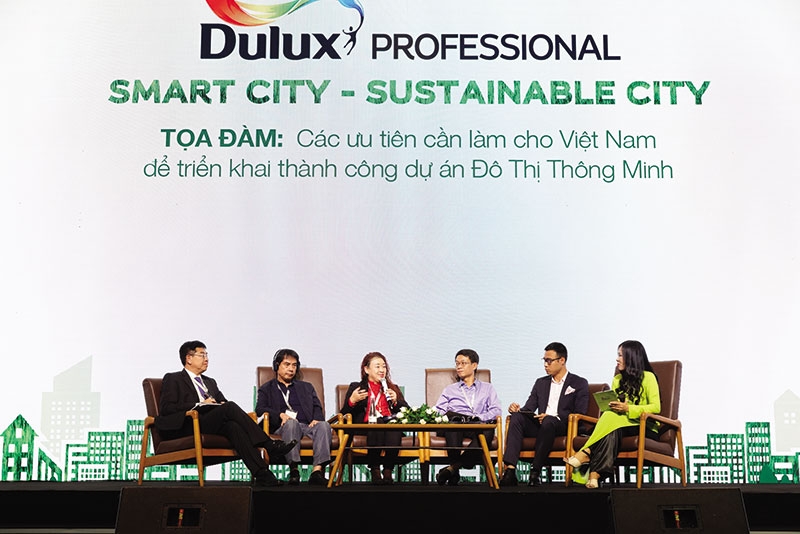Collaboration needed to build smart cities in Vietnam
 |
| With smart city development in Vietnam still in its infancy, stakeholders need to band together |
Challenges are ahead
While the country currently has more than 800 cities nationwide, there are only two mega-cities – Hanoi and Ho Chi Minh City, home to some 30 per cent of the total population. According to Tran Quoc Thai, deputy director of the Urban Development Department under the Ministry of Construction, despite them being the capital and the largest commercial city in Vietnam, the current development of these two cities is unable to accommodate the actual growth of their population and the economic expansion.
“Tremendous pressure has been placed on the infrastructure system and living spaces of those cities. The infrastructure system, in particular, has yet to meet the community’s demand for basic utilities and economic activities,” Thai noted at a conference entitled “Smart city, sustainable city” held by Dulux Professional, the paint and coating brand of AkzoNobel, in early June.
Investment in urban development in Vietnam, according to Thai, is considered to be spread out rather than concentrated on what is needed most or prioritised. In addition, urban management is far from effective and its capacity has not been keeping up with the requirements. “The ability to fight climate change among Vietnam’s cities isn’t sufficient at this stage,” he added.
The need to upgrade these cities into smart ones is thus urgent and is now the focus of a project named “Smart urban development in Vietnam by 2025, with a vision to 2030”.
Time to take steps
In its quest to build smart cities, Vietnam can learn from the experience that the island city-state of Singapore has accumulated over the years.
Larry Ng, group director of Architecture and Urban Design Excellence at the Urban Redevelopment Authority under Singapore’s Ministry of National Development said that for any city, including those in Vietnam, to be developed and become a smart city requires an understanding of what is smart and sustainable and what exactly is needed in a smart city.
“To me, many cities around the world are developing in their own way, but the most important factor is the leadership and governance in these cities. If you look at all the cities that are very successful, you will probably find that they are either very dedicated or they have a very good policymaker to make a difference in the city. And, of course, basic education and people are also factors that are important to the city,” said Ng.
However, Ng stressed that each city is different in terms of people, language, culture, leadership, politics, and economic situation, so one city cannot replicate exactly what another has done. “If Singapore had not had the issue of land constraint, we would have developed in a different way. Here in Vietnam, land is not as much of an issue.”
Once stakeholders have identified what is needed to build smart cities, the process will go to the next stage – pulling up the sleeves and getting hands-on with collaboration between stakeholders, including the government, urban planners, architects, contractors, investors, and more, to ensure smart cities will become a reality in a bid to improve the quality of life for their citizens.
 |
| Pamela Phua |
According to Pamela Phua, general director of AkzoNobel Vietnam, collaboration between various stakeholders will ensure the success of implementing smart cities. She gave the example of how Singapore collaborated under a government plan, from the planning stage, where the government set the tone, to the collaboration stage, where the government itself worked with private organisations toward the set goal.
Speaking on the example of the construction of the Vertical Green City in Singapore, Phua noted that when it was decided that plants would be put into a vertical garden, paint suppliers like themselves faced difficulties, as their paints normally contain biocides; every time it rained, the biocide would leak out and kill the plants. “This meant that we had to collaborate very seriously and plan for the future. So, for this project, we worked with the University of Singapore on irrigation to ensure that the plants can be kept alive.
“Dulux Professional recently launched a Weathershield paint that uses encapsulated biocides. They still preserve the wall to make sure it is anti-algae and anti-fungus, but the biocide is contained and no longer leaks out with water. It is controlled and released at a fixed interval and concentration that we need to preserve the building,” said Phua.
“This is just one example of a very serious collaboration that we have with the government and expert agencies to develop solutions for urbanisation and sustainable development toward the establishment of smart cities,” she added.
What the stars mean:
★ Poor ★ ★ Promising ★★★ Good ★★★★ Very good ★★★★★ Exceptional
Related Contents
Latest News
More News
- Schaeffler reports strong early output from Dong Nai solar project (December 12, 2025 | 15:16)
- Forestry conference highlights biodiversity and sustainability goals (December 09, 2025 | 13:35)
- Home Credit honoured among top 10 sustainable companies in trade and services (December 09, 2025 | 12:18)
- SCG and seven member companies honoured in Top 100 Sustainable Businesses 2025 (December 08, 2025 | 09:00)
- Nestlé Vietnam pioneers sustainable development and promotes business connections (December 06, 2025 | 12:09)
- CSI 2025 highlights rise of Vietnam’s green champions (December 06, 2025 | 09:00)
- Acecook Vietnam named among top 100 sustainable businesses (December 06, 2025 | 08:00)
- Vietnam’s forest carbon credits draw global interest (December 05, 2025 | 17:41)
- Coro Energy to launch BESS Pilot in Vietnam (December 04, 2025 | 15:12)
- Vietnam strengthens energy storage pathway (December 04, 2025 | 15:05)

 Tag:
Tag:






















 Mobile Version
Mobile Version